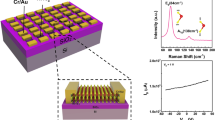Abstract
The single-layer black phosphorus is characterized by its puckered configuration that possesses the hinge-like behavior, which leads to the highly anisotropic in-plane Poisson’s ratios and the negative out-of-plane Poisson’s ratio. We demonstrate that the hinge-like mechanism can be described by the angle—angle cross interaction, which, combined with the bond stretching and angle bending interactions, is able to provide a good description for the mechanical properties of single-layer black phosphorus. We also propose a nonlinear angle—angle cross interaction, which follows the form of Stillinger—Weber potential and can be advantageous for molecular dynamics simulations of single-layer black phosphorus under large deformation.
Similar content being viewed by others
References
J.-W. Jiang, H.S. Park, Mechanical properties of single-layer black phosphorus, J. Phys. D: Appl. Phys. 47 (2014) 385304.
J. Qiao, X. Kong, Z.-X. Hu, F. Yang, W. Ji, High-mobility transport anisotropy and linear dichroism in few-layer black phosphorus, Nat. Commun. 5 (2014) 4475.
G. Qin, Z. Qin, S.-Y. Yue, H.-J. Cui, Q.-R. Zheng, Q.-B. Yan, G. Su, Hinge-like structure induced unusual properties of black phosphorus and new strategies to improve the thermoelectric performance, Sci. Rep. 4 (2014) 6946.
Q. Wei, X. Peng, Superior mechanical flexibility of phosphorene and few-layer black phosphorus, Appl. Phys. Lett. 104 (2014) 251915.
J.-W. Jiang, H.S. Park, Negative Poisson’s ratio in single-layer black phosphorus, Nat. Commun. 5 (2014) 4727.
M. Elahi, K. Khaliji, S.M. Tabatabaei, M. Pourfath, R. Asgari, Modulation of electronic and mechanical properties of phosphorene through strain, Phys. Rev. B 91 (2014) 115412.
Y. Du, J. Maassen, W. Wu, Z. Luo, X. Xu, P.D. Ye, Auxetic black phosphorus: a 2d material with negative Poisson’s ratio, Nano Lett. 16 (2016) 6701–6708.
F. Scarpa, Auxetic materials for bioprostheses, IEEE Signal Process. Mag. 25 (2008) 126–128.
J.B. Choi, R.S. Lakes, Design of a fastener based on negative Poisson’s ratio foam, Cell Polym. 10 (1991) 205–212.
Y. Sun, N. Pugno, Hierarchical fibers with a negative Poisson’s ratio for tougher composites, Materials 6 (2013) 699–712.
Y.J. Park, J.K. Kim, The effect of negative Poisson’s ratio polyurethane scaffolds for articular cartilage tissue engineering applications, Adv. Mater. Sci. Eng. 2013 (2013) 853289.
Q. Liu, Literature Review: Material with Negative Poisson’s Ratios and Potential Applications to Aerospace and Defence, DSTO Defence Science and Technology Organisation, Australia, 2006.
C. Kaneta, H. Katayama-Yoshida, A. Morita, Lattice dynamics of black phosphorus, Solid State Commun. 44 (1982) 613–617.
J.-W. Jiang, Parameterization of Stillinger–Weber potential based on valence force field model: application to single-layer MoS2 and black phosphorus, Nanotechnology 26 (2015) 315706.
D. Midtvedt, A. Croy, Comment on „parameterization of Stillinger–Weber potential based on valence force field model: application to single-layer MoS2 and black phosphorus’, Nanotechnology 27 (2016) 238001.
Y. Takao, Electronic structure of black phosphorus: tight binding approach, Physica (Amsterdam) 105B (1981) 580.
J.D. Gale, Gulp: a computer program for the symmetry-adapted simulation of solids, J. Chem. Soc. Faraday Trans. 93 (1997) 629. Code available from https://projects.ivec.org/gulp/.
LAMMPS, http://www.cs.sandia.gov/~sjplimp/lammps.html.
S. Nosé, A unified formulation of the constant temperature molecular dynamics methods, J. Chem. Phys. 81 (1984) 511.
W.G. Hoover, Canonical dynamics: equilibrium phase-space distributions, Phys. Rev. A 31 (1985) 1695.
W. Ji. Private communication, 2015.
N. Karasawa, S. Dasgupta, W.A Goddard III, Mechanical properties and force field parameters for polyethylene crystal, J. Phys. Chem. 95 (1991) 2261.
N. Karasawa, W.A Goddard III, Force fields, structures, and properties of poly(viny1idene fluoride) crystals, Macromolcules 25 (1992) 7268–7281.
J.A. Wendel, W.A. Goddard III, The Hessian biased force field for silicon nitride ceramics: predictions of thermodynamic and mechanical properties for α- and β-Si3N4, J. Comput. Phys. 97 (1992) 5048.
R.J. Meier, J.R. Maple, M.-J. Hwang, A.T. Hagler, Molecular modeling urea- and melamine-formaldehyde resins. 1. A force field for urea and melamine, J. Phys. Chem. 99 (1995) 5445–5456.
B. Ma, R. Nussinov, Stabilities and conformations of Alzheimer’s p-amyloid peptide oligomers: sequence effects, Proc. Natl. Acad. Sci. U.S.A. 99 (2002) 14126–14131.
K. Kuwata, T. Matumoto, H. Cheng, K. Nagayama, T.L. James, H. Roder, NMR-detected hydrogen exchange and molecular dynamics simulations provide structural insight into fibril formation of prion protein fragment 106–126, Proc. Natl. Acad. Sci. U.S.A. 100 (2003) 14790–14795.
Z. Zhu, D. Tomanek, Semiconducting layered blue phosphorus: a computational study, Phys. Rev. Lett. 112 (2014) 176802.
L. Kou, Y. Ma, S.C. Smith, C. Chen, Anisotropic ripple deformation in phosphorene, J. Phys. Chem. Lett. 6 (2015) 1509–1513.
Author information
Authors and Affiliations
Corresponding author
Rights and permissions
About this article
Cite this article
Jiang, JW. An empirical description for the hinge-like mechanism in single-layer black phosphorus: The angle—angle cross interaction. Acta Mech. Solida Sin. 30, 227–233 (2017). https://doi.org/10.1016/j.camss.2017.04.002
Received:
Revised:
Accepted:
Published:
Issue Date:
DOI: https://doi.org/10.1016/j.camss.2017.04.002




